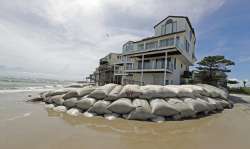Hurricane Florence’s uncertain track sows fear; 10 million in crosshairs
Faced with new forecasts that showed a more southerly threat, Georgia’s governor joined his counterparts in Virginia and North and South Carolina in declaring a state of emergency, and some residents who had thought they were safely out of range boarded up their homes.

Hurricane Florence put a corridor of more than 10 million people in the crosshairs Wednesday as the monster storm closed in on the Carolinas, uncertainty over its projected path spreading worry across a widening swath of the Southeast.
Faced with new forecasts that showed a more southerly threat, Georgia’s governor joined his counterparts in Virginia and North and South Carolina in declaring a state of emergency, and some residents who had thought they were safely out of range boarded up their homes.
The National Hurricane Center’s best guess was that Florence would blow ashore as early as Friday afternoon around the North Carolina-South Carolina line, then push its rainy way westward with a potential for catastrophic inland flooding.
Florence’s nighttime winds were down to 110 mph (175 kph) from a high of 140 mph (225 kph), and the Category 3 storm fell to a Category 2, with a further slow weakening expected as the storm nears the coast. But authorities warned it will still be an extremely dangerous hurricane.
“Do you want to get hit with a train or do you want to get hit with a cement truck?” said Jeff Byard, an administrator with the Federal Emergency Management Agency.
Tropical storm-force winds extended 195 miles (315 kilometers) from Florence’s center, and hurricane-force winds reached out 70 miles (110 kilometers).
The National Weather Service said 5.25 million people live in areas under hurricane warnings or watches, and 4.9 million live in places covered by tropical storm warnings or watches.
At the White House, President Donald Trump both touted the government’s readiness and urged people to get out of the way of Florence.
“Don’t play games with it. It’s a big one,” he said.
As of 11 p.m., the storm was centered 280 miles (455 kilometers) southeast of Wilmington, North Carolina, moving northwest at 17 mph (28 kph). The hurricane center said Florence will approach the coast Friday and linger for a while before rolling ashore.
As of Tuesday, more than 1.7 million people in the Carolinas and Virginia were warned to clear out. Airlines had canceled nearly 1,000 flights and counting. Home Depot and Lowe’s activated emergency response centers to get generators, trash bags and bottled water to stores before and after the storm. The two hardware chains said they sent in a total of around 1,100 trucks.
Duke Energy, the nation’s No. 2 power company, said Florence could knock out electricity to three-quarters of its 4 million customers in the Carolinas, and outages could last for weeks. Workers are being brought in from the Midwest and Florida to help in the storm’s aftermath, it said.
Boarding up his home in Myrtle Beach, South Carolina, Chris Pennington watched the forecasts and tried to decide when to leave.
“In 12 or 18 hours, they may be saying different things all over again,” he said.
Computer models of exactly what the storm might do varied, adding to the uncertainty. In contrast to the hurricane center’s official projection, a highly regarded European model had the storm turning southward off the North Carolina coast and coming ashore near the Georgia-South Carolina line.
Reacting to the possibility of a more southerly track, Georgia Gov. Nathan Deal declared an emergency but did not immediately order any evacuations.
“I ask all Georgians to join me in praying for the safety of our people and all those in the path of Hurricane Florence,” Deal said.
The shift in the projected track spread concern to areas that once thought they were relatively safe. In South Carolina, close to the Georgia line, Beaufort County emergency chief Neil Baxley told residents they need to prepare again for the worst just in case.
“We’ve had our lessons. Now it might be time for the exam,” he said.
In Virginia, where about 245,000 residents were ordered to evacuate low-lying areas, officials urged people to remain away from home despite forecast changes showing Florence’s path largely missing the state.
Their entire neighborhood evacuated in Wilmington, North Carolina, David and Janelle Garrigus planned to ride out Florence at their daughter’s one-bedroom apartment in Charlotte. Unsure of what they might find when they return home, the couple went shopping for a recreational vehicle.
“We’re just trying to plan for the future here, not having a house for an extended period of time,” David Garrigus said.
Melody Rawson evacuated her first-floor apartment in Myrtle Beach and arrived at Atlanta Motor Speedway in Hampton, Georgia, to camp for free with three other adults, her disabled son, two dogs and a pet bird.
“We hope to have something left when we get home,” she said.
Forecasters worried the storm’s damage will be all the worse if it lingers on the coast. The trend is “exceptionally bad news,” said University of Miami hurricane researcher Brian McNoldy, since it “smears a landfall out over hundreds of miles of coastline, most notably the storm surge.”
With South Carolina’s beach towns more in the bull’s-eye because of the shifting forecast, Ohio vacationers Chris and Nicole Roland put off their departure from North Myrtle Beach to get the maximum amount of time on the sand. Most other beachgoers were long gone.
“It’s been really nice,” Nicole Roland said. “Also, a little creepy. You feel like you should have already left.”